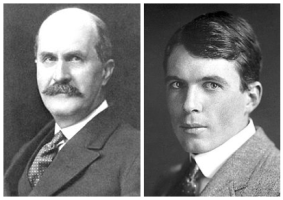Nobel Prizes in Crystallography
There have been a significant number of Nobel prizes awarded where crystallography has been one of the key aspects of the research. These have been spread across Chemistry and Physics (but with many significant aspects also related to Biological applications) and Physiology or Medicine.
This started in 1901 with the Nobel Prize for Physics awarded to Röntgen for his discovery of X-rays. This was followed up by Max von Laue (discovery of diffraction of X-rays by crystals) and the two Braggs who demonstrated the first determination of crystal structures.



Other significant Nobel Prizes were awarded to Dorothy Hodgkin for the determination of biological molecules including vitamin B12 (Chemistry 1964), Watson, Crick and Wilkins for determining the structure of DNA (Physiology or Medicine 1962) and Curl, Kroto and Smalley who discovered the fullerene form of carbon (also known as bucky balls) (Chemistry 1996).
2013 Chemistry
M. Karplus, M. Levitt and A. Warshel
For the development of multiscale models for complex chemical systems
2012 Chemistry
R. J. Lefkowitz and B. K. Kobilka
For studies of G-protein-coupled receptors
2011 Chemistry
D. Shechtman
For the discovery of quasicrystals
2010 Physics
A. Geim and K. Novoselov
For groundbreaking experiments regarding the two-dimensional material graphene
2009 Chemistry
V. Ramakrishnan, T. A. Steitz and A. E. Yonath
Studies of the structure and function of the ribosome
2006 Chemistry
R. D. Kornberg
Studies of the molecular basis of eukaryotic transcription
2003 Chemistry
R. MacKinnon
Potassium channels
1997 Chemistry
P. D. Boyer, J. E. Walker and J. C. Skou
Elucidation of the enzymatic mechanism underlying the synthesis of adenosine triphosphate (ATP) and discovery of an ion-transporting enzyme
1996 Chemistry
R.Curl, H. Kroto and R. Smalley
Discovery of the fullerene form of carbon
1994 Physics
C. Shull and N. Brockhouse
Neutron diffraction
1992 Physics
G. Charpak
Discovery of the multi wire proportional chamber
1991 Physics
P.-G. de Gennes
Methods of discovering order in simple systems can be applied to polymers and liquid crystals
1988 Chemistry
J. Deisenhofer, R. Huber and H. Michel
For the determination of the three-dimensional structure of a photosynthetic reaction centre
1985 Chemistry
H. Hauptman and J. Karle
Development of direct methods for the determination of crystal structures
1982 Chemistry
A. Klug
Development of crystallographic electron microscopy and discovery of the structure of biologically important nucleic acid–protein complexes
1976 Chemistry
W. N. Lipscomb
Structure of boranes
1972 Chemistry
C. B. Anfinsen
Folding of protein chains
1964 Chemistry
D. Hodgkin
Structure of many biochemical substances including Vitamin B12
1962 Physiology or Medicine
F. Crick, J. Watson and M. Wilkins
The helical structure of DNA
1962 Chemistry
J. C. Kendrew and M. Perutz
For their studies of the structures of globular proteins
1954 Chemistry
L. C. Pauling
For his research into the nature of the chemical bond and its application to the elucidation of the structure of complex substances
1946 Chemistry
J. B. Sumner
For his discovery that enzymes can be crystallised
1937 Physics
C. J. Davisson and G. Thompson
Diffraction of electrons by crystals
1936 Chemistry
P. J. W. Debye
For his contributions to our knowledge of molecular structure through his investigations on dipole moments and on the diffraction of X-rays and electrons in gases
1929 Physics
L.-V. de Broglie
The wave nature of the electron
1917 Physics
C. G. Barkla
Discovery of the characteristic Röntgen radiation of the elements
1915 Physics
W. H. Bragg and W. L. Bragg
Use of X-rays to determine crystal structure
1914 Physics
M. Von Laue
Diffraction of X-rays by crystals
1901 Physics
W. C. Röntgen
Discovery of X-rays